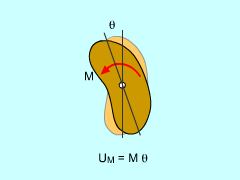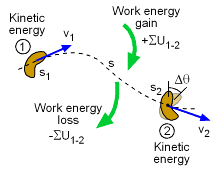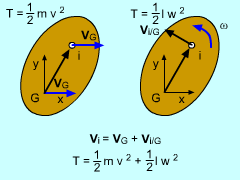| Ch 7. Rigid Body Energy Methods | Multimedia Engineering Dynamics | ||||||
| Rot. Work & Energy | Conservation of Energy | ||||||
| Rotational Kinetic Energy and Work | Case Intro | Theory | Case Solution | Example |
| Chapter |
| - Particle - |
| 1. General Motion |
| 2. Force & Accel. |
| 3. Energy |
| 4. Momentum |
| - Rigid Body - |
| 5. General Motion |
| 6. Force & Accel. |
| 7. Energy |
| 8. Momentum |
| 9. 3-D Motion |
| 10. Vibrations |
| Appendix |
| Basic Math |
| Units |
| Basic Dynamics Eqs |
| Sections |
| eBooks |
| Dynamics |
| Fluids |
| Math |
| Mechanics |
| Statics |
| Thermodynamics |
| ©Kurt Gramoll |
|
|
|||||||||||||||
| General Work |
|||||||||||||||
|
|
The Principle of Work and Energy equates the total work performed on a body to the change in kinetic energy, Σ Work = Δ Kinetic Energy Another way to express this concept is where Work on a rigid body is the same as work on a particle, with the addition of rotational energy. Recall from Particle Energy Methods section, there are various ways to model energy for a particle. These are listed in the table at the left. |
||||||||||||||
 Rotating Rigid Body |
Work of a Force Couple, or Moment |
||||||||||||||
|
The work of two parallel, non-collinear forces in opposite directions with equal magnitudes forms a couple and moment. This moment generate energy similar to a linear force through a distance. However, the distance is now the angle of rotation.
|
|||||||||||||||
| Kinetic Energy for a Rotating Body |
|||||||||||||||
|
|
For a particle that has no rotation, the kinetic energy is simply, T = 1/2 m v2 This equation can be applied to every particle that makes up a rigid body, However, if the particle is a rigid body with dimensions, then the velocity needs to be written as where G is the center of gravity. The second terms models the rotation of the object. Substituting vi into the kinetic equation and noting that a magnitude of vi/G = ri/G ω gives If the rigid body has a fixed point, then the equation becomes T = 1/2 Io ω2 where Io is moment of inertia about the fixed point. |
||||||||||||||


